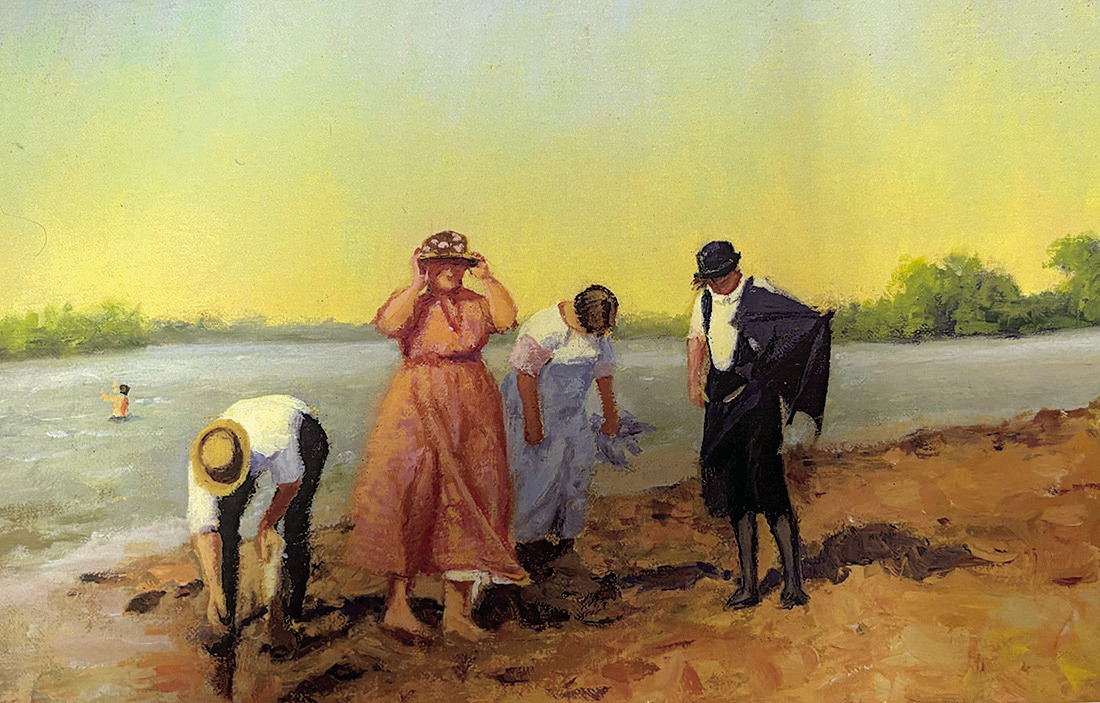Author Janet Timmerman shares her love of the outdoors and Lake Shetek through her new book
Halcyon Days: a. a fortnight of calm weather during the winter solstice; b. a period of peace and happiness.
On a Sunday afternoon that she admitted would’ve been more suited for spending time on Lake Shetek than sitting inside hearing about lake life, author and historian Janet Timmerman transported a group of people back in time to an era of leisure, which she referred to through her new book as halcyon days.
Timmerman, who grew up on a farm near Lake Wilson, was the director of the Murray County Historical Society until her recent retirement. She was inspired to write her book, “Halcyon Days, Leisure on Lake Shetek,” not just by her admiration of the Lake Shetek area, but also by the need to fill her time after retiring.
“I needed something in between — I needed to go from full-time work to full-time not having anything to do,” she said at her book reading Sunday at the Wheels Across the Prairie Heritage Center. “Plus, we had just gone through COVID, so I had to spend a lot of time at home. I said, ‘I think I can retire, but I’m going to have to have a project.”
That project — three years in the making — was her “Halcyon Days” book, which perfectly blends Timmerman’s love of the outdoors and history. As museum director, Timmerman had been researching Valhalla Island, which she shared at the Dinehart Lunchbox Lecture.
“There just seemed to be a lot more that we can add to that,” she said.
Timmerman went on to publish a threepart series for the Sailor, and from that, the first chapter in her new book started to develop. But “Halcyon Days” — her first independently-published work — isn’t a history book.
“I didn’t want it to be pure history,” she said. “It was going to be contemplative and talk about how we work with the environment to create something where we want to be. Sometimes, we have to moderate how we work within an environment.”
Timmerman joked that writing about local history can be problematic because local history is always subject to one’s own memory and personal history.
“People will find things in the book and say, ‘Well, I don’t remember it quite that way,’” she quipped.
She added that one can’t Google local history. Instead, she found herself finding information in some rather obscure places — “like the basement of the bar in Hadley, little museums, in courthouses in the backroom in odd records — you have to kind of dig,” she said. “Sometimes, they’re even in someone’s basement or garage. The other place is newspaper offices — you can find whatever you’re looking for there. Newspapers are a great source of information. A lot the stories you’ll read in this book — a lot of them came out of newspapers.”
Timmerman said she gleaned a lot of information from the late Bill Bolin, southwest Minneota’s one-time resident expert on Lake Shetek.
And then there are face-to-face connections that she made during her research process and how every corner of the area has its own experts.
“If you’re looking for someone who knows about Shetek history, you go to Mr. (Jesse) James; if you’re looking for someone who knows Westbrook or Walnut Grove history, you go see Dan Peterson; if you want someone who knows Currie history, you go see Romane Dold,” she said. “There’s lots of local experts that you go to that are more than willing to share their information with you.”
Timmerman’s book contains some personal stories — although she calls including those a “total no-no” for a historical piece. However, she was inspired to do so because of how Bolin included personal anecdotes in his writings about the Shetek area.

THE ARTWORK for Janet Timmerman’s book was provided by Diane Foster, who grew up north of Slayton. The image is from one of Timmerman’s family scrapbooks and feature’s her husband’s relatives.
“One thing that was really interesting is that I was able to take old research and combine it with new research,” Timmerman said. “I did a lot of interviews with people — Romane Dold, Trevor Humphrey, Jim Keul, Gene Jacobson. “This book looks at the memories and experiences that people have about Lake Shetek and how they find a place and create a place in nature, and how they do everything they can to keep that place intact, so they can continue to enjoy it.”
Lake Shetek State Park, Timmerman wrote, has always held a mystique of sorts for her. In her book, she not only flashes back with memories of the area, she also touched on environmental issues around the lake, inparticular what was known as the “green curse.”
“There were different issues with the lake,” she said. “Quantity — how much water should be in the lake — the quality of the water and all the fishing issues. The ‘green curse’ was the algae blooms that happened and still happen today.”
In her book, Timmerman reflected on nitrate issues in the lake, with a focus on 1956, when the Murray County Soil & Water used all of its tools to tackle agricultural pollution problems — money for conservation programs, commendations for farmers who conserved the land, and programs to educate residents about the problems. The Shetek Area Rural Development Association was formed in 1964, she wrote, with its focus on the “green curse.” The residents of the time were just leaning how conservation practices could improve the water quality.
“A more immediate solution was called for however, and they decided to do chemical treatments on the lake,” Timmerman wrote. “Copper sulfate kills algae and forces it to the bottom of the lake with little to no effect on fish and beneficial plants.”
At the time, the treatment of the lake was the largest project of its kind in Minnesota. Local boat owners were asked to evenly spread the chemical over the water, “and people came in droves. It was an inland Navy of 40 boats that answered the call. They spread 9,000 pounds of copper sulfate in all corners of the lake.”
Two treatments for a total of $,4,000 were applied within a month, Timmerman wrote, because of algae’s tremendous growth rate when given sufficient nutrients.
“They got legislators involved, and that’s what has helped over time,” said Timmerman.



